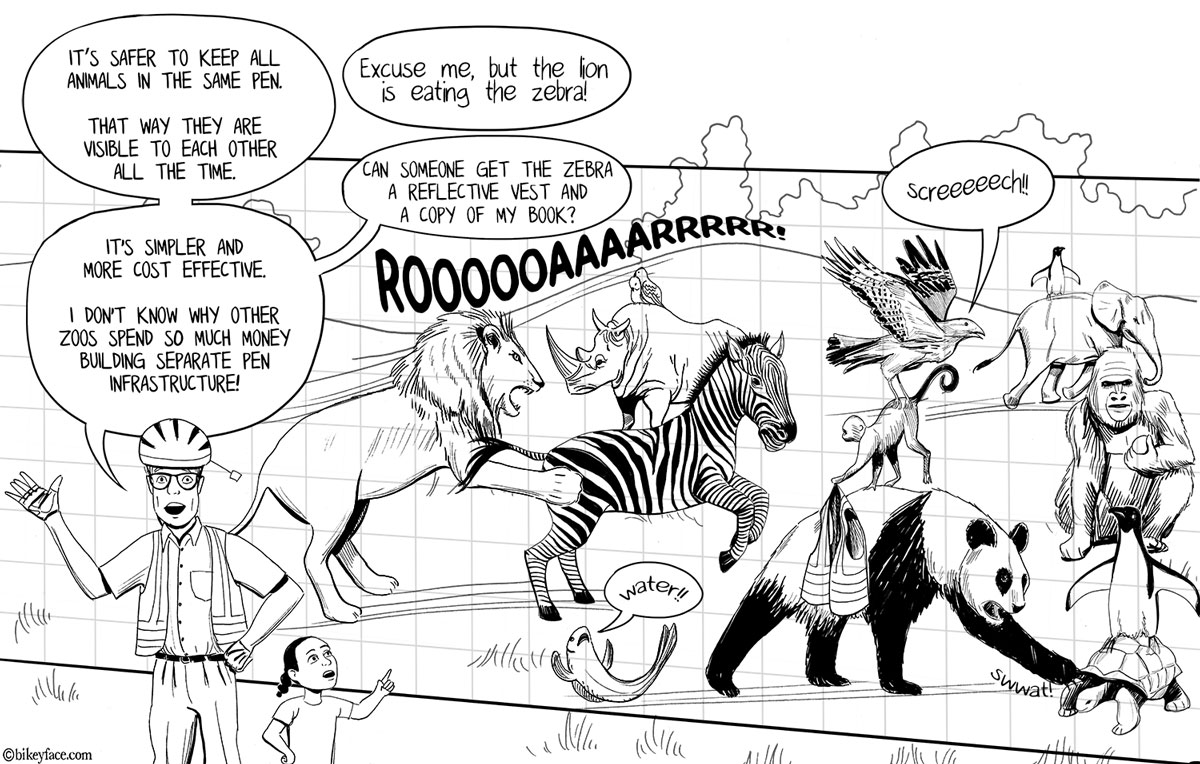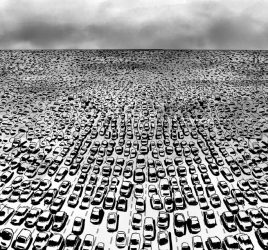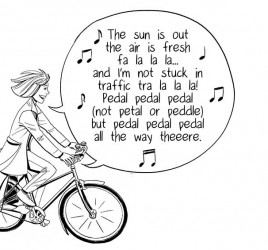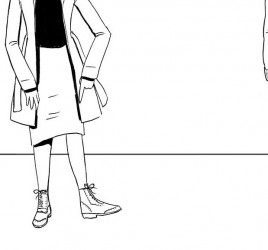
A Zoo
I have to bicycle vehicularly most of the time because there’s not much infrastructure yet. But I’d prefer not to. What I can’t understand why anyone would argue against protected bike lanes.
I wonder how the argument would go if applied to other things- like a zoo?





“I don’t have a problem with protected bike lanes. My problem comes from some posts seem to imply that they are the only solution.”
Has anyone suggested that? Or implied that all roads should be segregated regardless of whether they need it or not?
Not here, and I don’t remember anyone stating that explicitly. But on other blogs/message boards where this comes up a large portion of the segregated facility proponents either are dismissive of or don’t even mention other possible solutions. I am one of those that think the correct solution depends on many factors, including but not limited to, lane width, number of lanes, traffic volume, and traffic speed.
Quite as important as segregated tracks in making Dutch cycling so ubiquitous, safe and pleasant is that country’s law of strict liability – shared by all but four states in the European Union – which lays down that in the event of a motor vehicle hitting a cyclist the vehicle’s driver will be assumed to be at fault unless it can be shown otherwise. Another factor is that the Dutch driving test contains a cyclist-awareness module, and that cycle training is part of the junior-school curriculum. And then there’s the sheer numbers of cyclists: when you drive in Holland anywhere but on a main arterial road you’re always on the lookout for them.
As I’ve pointed out already, only some 22% of the total Dutch metalled-road kilometrage is cycle-tracked: everywhere else it’s shared-use with painted strips along the road edges. But the 22% are the fast, busy roads where accidents would otherwise be most likely to occur.
“What it has currently is both a MUP and an on street painted bike lane which actually seems to work quite well.”
A little background on why my city is going with both MUPS and bike lanes in some locations. I live in Rochester MN, a city of a little over 100,000 people. Our largest employer, the Mayo Clinic, is located right smack downtown. The clinic’s waiting list for employer provided parking is currently in excess of eight years and climbing. The modal share for downtown commuting is right about 8% for pedestrian/bike.
The driving force behind the MUP and bike lane on the same street was cyclists themselves. There was a local study done and two facts came out. The beginning cyclists were almost as afraid of other cyclists as they were of the cars, and the experienced cyclists didn’t like having to deal with pedestrians and slow riders. The city was also getting complaints from other MUP users about the faster cyclists. So on some of the arterial streets they are removing parking to put in bike lanes for the faster riders leaving the MUPS for the slower or beginning rider and other users.
“So on some of the arterial streets they are removing parking to put in bike lanes for the faster riders leaving the MUPS for the slower or beginning rider and other users.”
Yes, this is precisely the “dual-provision” philosophy which has been followed by traffic planners in Britain for the past forty years. And which has produced a cycling infrastructure which is exiguous, ill-conceived, poorly constructed where it exists and generally of use neither to God nor man: something which set out to please both the self-styled “Real Cyclists” and the poor timid 9mph bimblers, and ended up satisfying neither.
Sorry, but it has to be either one or the other: segregated tracks everywhere that cyclists are in serious danger from motor traffic (…the corollary of which is cyclists legally barred from the vehicle carriageway running alongside) or the present free-for-all in which (in the UK at any rate) cyclists are already de facto barred from using the country’s arterial A-class roads since they’re too suicidally dangerous for even the most intrepid Vehicular Cyclist to attempt them. With the first alternative you might one day see cycling’s modal share reach 10 or even 15% even in the USA: with the second it’ll certainly never be more than 3%.
By the way, living in the Netherlands I couldn’t help observing that despite their never mixing sport and utility cycling, the Dutch still manage to have a pretty impressive presence in the former. How would you explain that?
The importance of the “strict liability” angle cannot be overlooked. Liability in the US is based on “negligence” with defenses permitted of “comparative negligence” of the cyclist. Not having to prove “negligence” in these claims is a major factor influencing driver behavior…
In case any should think that I “have it in” for Vehicular Cycling, as we say in England, I have to state that we owe them a great deal even if their day has now passed. I’ve been cycling since 1958, and I well remember how, at the end of the 1960s in Britain, non-sport cycling was in such steep decline and the motor car so apparently triumphant that there was a very real possibility that the former might disappear altogether: motoring-association annual conferences featuring motions calling for bikes to be barred from the vehicle carriageway and confined to pavements etc. It was the small band of Vehicular Cyclists – though no-one called them that in those days – who went on doggedly asserting the right of cyclists to be considered as road-users at all.
The trouble was that like many resistance movements, in order to survive it took on some of the crushing dogmatism of its opponents and fell into the way of thinking that its own mode of cycling was the only one there was, all others being but inferior copies of it. And most unfortunately in Britain, where tribal warfare not cricket is the true national sport, its followers began adopting a distinctive style of dress and various cultish mannerisms which led the wider public and much of officialdom to assume that all cyclists were like that: not ordinary members of the public going about their business on bicycles but a crankish and cantankerous gang of mostly-male road warriors demanding that the taxpayer subsidise their own eccentric hobby. It is a highly damaging perception which has only recently begun to be unpicked: participants in a recent London mass-cycle rally being asked specifically not to turn up wearing helmets and hi-viz since that only reinforces the public view of cyclists as somehow not quite like everyone else…
I haven’t read every word of every comment, so forgive me if this point has been raised – as one who has represented 350+ cyclists in “bike cases” involving, usually, errant motorists, I often find myself arguing “negligence” issues in court – whether the motorist was ‘negligent,” whether my cycling client was “negligent” in some way and what the “cause” of the crash was.
I find this passage from an article on Dutch cycling very interesting…
“Accidents do still happen of course, but in the event of a collision involving a cyclist, insurers refer to Article 185 of the Dutch Road Safety Code which deals with something called “strict liability”. It is often mistakenly interpreted as a law that establishes guilt. What it essentially means is the driver will usually be expected to cover at least 50% of the financial costs to the cyclist and their bike.”
Strict liability in the U.S. means that the injured party does not have to prove “fault” – or “negligence” – [Magas Note: This provides Dutch “bike lawyers” with a huge advantage!] This assignment of blame to the motorist, and the resulting assignment of monetary cost, is a huge factor in changing behavior and making motorists be more careful. http://www.bbc.com/news/magazine-23587916
From another article:
“To sum up: in the Netherlands, if a motor vehicle hits a cyclist, the accident is always assumed to have been the driver’s fault, not the cyclist’s. As explained in this FAQ from the ANWB, the Dutch tourism and car owners’ organisation, “the law treats pedestrians and cyclists as weaker participants in traffic… The driver of the motor vehicle is liable for the accident, unless he can prove he was overpowered by circumstances beyond his control (overmacht). The driver must thus prove that none of the blame falls on him, which is extremely difficult in practice.”
“This regulatory regime places an extra burden on drivers. That burden can be summed up as follows: before you turn, you have to check carefully in the mirror to see whether there’s a cyclist there. That’s it. When you are driving in the Netherlands, you have to be more careful than you would when driving in America. Does this result in rampant injustice to drivers when accidents occur? No. It results in far fewer accidents. As the ANWB says, some drivers may think the liability treatment gives cyclists “a blank check to ignore the rules. But a cyclist is not going to deliberately ride through a red light thinking: ‘I won’t have to pay the damages anyway.’ He is more likely to be influenced by the risk that he will land in the hospital.””
This bit of legal magic adds to the mystique of Dutch cycling issues and plays a role in changing the “car culture” by slapping the motorist with possible monetary penalties for hitting a cyclist. The motorist can still prove facts to get out of it, but she/he starts in a hole dug by the “strict liability” language of the law.
I am not anti-infrastructure. However, it’s not a panacea – and it is certainly not something to be done without careful thought. The problems arise at the pinch points – every driveway – every intersecting road. Drivers going your way who want to turn right… drivers pulling out from your right who “don’t see” you riding so close to the curb. Motorists coming towards you who fail to “perceive” you scooting along in the far right lane… the same pinch point issues cyclists face without having “infrastructure”- perhaps magnified by the cyclist’s position so far to the right –
Here in Cincinnati we have some bike lanes that have helped tremendously to calm traffic on roads which used to be driven like race tracks. However, our new “protected’ bike lane has had its share of difficulties including an uptick in crashes… This past week a story in the Cincinnati media reviewed some of the problems with the “Road/Parking/Bike Lane” placement of our new protected infrastructure … http://www.local12.com/news/features/top-stories/stories/Bike-lane-mistake-City-officials-considering-changes-105380.shtml
Maintenance of the segregated facilities is also an issue. Pedestrian infrastructure, a sidewalk, requires minimal maintenance, minimal “cleaning” and occasional repair. If the city ignores a sidewalk for a decade or two the sidewalk is not likely to be the cause of catastrophic pedestrian injuries or death or to result in municipal liability. However, segregated bicycle facilities located on the edge of the street, where all the debris ends up anyway, need regular cleaning/sweeping and regular maintenance. If this is NOT done, then (A) Cyclists won’t use it and (B) the city can face liability if a cyclist is hurt or killed.
In Columbus, Ohio a couple years ago a friend of mine represented a cyclist injured [arguably] as the result of to road debris and potholes which the city failed to maintain… the results were catastrophic injuries. He won an appellate court decision holding that cities have a duty to all lawful road users, including cyclists, to keep the roads in good repair. Rather than take the case to a jury [where the city might win, or might lose BIG] the city elected to settle for $1.5 million… http://www.ohiobikelawyer.com/bike-law-101/2014/07/whats-a-pothole-worth-to-the-city-about-a-million-bucks/
So yes, infrastructure of many types can have a place in the world, can improve cycling conditions and can make cyclists happy. However, such facilities must be well thought out, carefully planned and designed, and regularly maintained. Even then, at least here in Ohio, it is likely to be limited to short stretches due to budget constraints. We can’t get our current legislature to pass a “3 Foot Law” and they have shown no consideration for spending money on cycling… in fact, they sometimes seem shocked to find out that cyclists are permitted on the roads at all…
Changes in “The Law” must also be considered along with infrastructure. Is the “protected bike lane” to be considered part of the “roadway?” What are the laws governing riding on the bike lane? What laws govern the way cars, trucks and busses interact with cyclists using the special infrastructure? Does the nature of a bicycle facility change when it is “protected” vs when there is just some green paint thrown down to make a “bike lane?”
I usually describe the world as divided into two parts – the part “ON” the “roadway” and the part “NOT ON” the roadway. The “Traffic Laws” apply to cyclists [and all vehicle operators] when they are operating bicycles ON the “roadway.” Bicycles are special, though, and unlike cars/trucks/busses, bicycles may be operated in areas of the world that are “not on” the roadway – in those cases, the traffic laws generally do not apply…The “roadway” is usually defined as being “white line to white line” with the stuff to the right of the white line being considered the “berm or shoulder” – Bike Lanes and protected infrastructure don’t always fit that paradigm.
Cyclists who are operating their bicycles ON the roadway have the duty to follow all the usual traffic laws relative to riding with, not against, traffic, stopping at stop signs, using lights at night etc etc… however if you are riding on the sidewalk, the “tree lawn” or someplace to the right of the white of the white line, even in the berm or shoulder, there are cases in many states holding that you are NOT governed by the traffic laws… For example,there are cases that say you do not have to use a light at night if you riding on the sidewalk… or the berm.. there are cases that say that riding against traffic is OK if you are not on the “roadway” because the “traffic laws” do not apply…
A cyclist who is uncomfortable riding in traffic, and who chooses to NOT use the roadway – to ride, say, on the berm instead of using the lane – gives up a very valuable right, probably the most important right in all of “Traffic-dom” – the “Right of Way” – people operating vehicles on the berm or shoulder do not have the right of way over vehicles operating on the roadway. There are special laws governing how you move your vehicle from a place not on the road to a place on the road – and the person not on the road must yield to everyone else. Once you cross the white line and are on the roadway a lawfully moving cyclist has exactly and precisely the same “right of way” as any other vehicle operator. Operators of bigger vehicles do not get bigger rights under the law… An analysis of the the “right of way” of one operating on the berm or shoulder or sidewalk does not fit the usual “traffic law” process…
So what is a “bike lane” or “protected bike lane”? Is it considered part of the statutorily defined “roadway” or part of the berm or simply not dealt with? How are they defined in the city/state codes? Do cities which have installed those types of infrastructure have special state or local laws defining them as part of the roadway? Do they have special laws defining how motorized traffic is supposed to manipulate its way through/over the bike lane?
In some states it is mandatory that cyclists use infrastructure. In Ohio, where my “Bike Law” practice is based, we do NOT have to use infrastructure…
I don’t know the answers … I suspect these are some of the “new” litigation issues that will crop as folks who are injured in protected bike lanes begin to litigate cases over their injuries…
Steve Magas
http://www.OhioBikeLawyer.com
Because “protected” bikeways don’t protect… because intersections. Not just with streets, but also with driveways, and alleys. At every crossing point crashes are exacerbated by such infrastructure. In Dutch environment with different traffic laws, different liability laws, and a different culture, they’re safer, but still cause maiming and death every year.
Because “protected” bikeways in urban and suburban areas are unsafe at normal bike speeds. In much of the USA typical trips are longer and require higher speeds.
Because “protected” bikeways are already mandatory in some areas, and are bound to made mandatory in more areas as more are built (and please don’t call them protected bike lanes because that just makes their mandatory use automatic any place bike lanes are already mandatory).
That’s why someone might argue against protected bikeways.
@Serge
“Because “protected” bikeways in urban and suburban areas are unsafe at normal bike speeds.”
There is overwhelming evidence to the contrary:
Number of people killed per 100 million kilometers cycled US (poor cycling infrastructure, mostly vehicular cycling): 5.8
Number of people killed per 100 million kilometers cycled Netherlands (excellent cycling infrastructure, vehicular cycling unknown): 1.1
Number of people injured per 10 million kilometers cycled US (poor cycling infrastructure, mostly vehicular cycling): 37.5
Number of people injured per 10 million kilometers cycled Netherlands (excellent cycling infrastructure, vehicular cycling unknown): 1.4
As Steve Magas writes, separated protected bike infrastructure has unclear legal status in many U.S. states – is it part of the roadway or not?
Strict liability would indeed give cyclists an advantage in recovering money for their injuries. I live in North Carolina, which has a ‘contributory negligence’ law. My state is unlikely to ever change this to comparative negligence.
The high hurdle for getting a drivers license and the harsh penalties for DUI in many european countries make the roads and sidewalks safer for all users. The lack of land in the Netherlands (in towns) to widen roads (due to canals) helps to encourage drivers to not speed.
If you are going to create separated infrastructure, you have to plan it well. You need to track the usage and plan to widen it if it becomes too crowded. You need to build the intersections with roads with sufficient sightlines. You also need to build this infrastructure to handle bicycles with cargo trailers and trikes and handcycles. The stereotypical MUP in a floodplain which gets damaged by flooding and gets pavement maintenance every 10 years is not a great example.